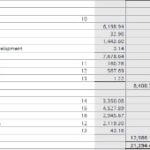
Compound interest (or compounding interest) is interest calculated on the initial principal, which also includes all the accumulated interest of previous periods of a deposit. Compound interest is an important concept to understand that is widely used in investing, finance, and banking. Compound interest is defined as the interest earned on a loan or investment that comes from both the initial principal and the accumulated interest.
Compound Daily Interest Calculator
The most comfortable way to figure it out is using the APY calculator, which estimates the EAR from the interest rate and compounding frequency. The interest rate is commonly expressed as a percentage of the principal amount (outstanding loan or value of deposit). Usually, it is presented on an annual basis, which is known as the annual percentage yield (APY) or effective annual rate (EAR). Daily compound interest is calculated using a version of the compound interest formula.To begin your calculation, take your daily interest rate and add 1 to it. Then, raise that figure to the power of the number of days you want to compound for. Subtract the starting balance from your total if you want just the interest figure.

Calculate Accrued Amount (Future Value FV) using A = P(1 + r/n)^nt

Think of this as twelve different compound interest calculations, one for each quarter that you deposit $135. At the end of three years, simply add up each compound interest calculation to get your total future value. In this example you earned https://www.online-accounting.net/what-are-the-three-types-of-accounts/ $1,000 out of the initial investment of $2,000 within the six years, meaning that your annual rate was equal to 6.9913%. In the second example, we calculate the future value of an initial investment in which interest is compounded monthly.
What is the compound interest formula?
- If an amount of $10,000 is deposited into a savings account at an annual interest rate of 3%, compounded monthly, the value of the investment after 10 years can be calculated as follows…
- This calculation is valuable if you have the desired outcome in mind.
- The more times theinterest is compounded within the year, the higher the effective annual interest rate will be.
- It’s designed to help users plan their financial future, whether for retirement, saving for a home, or understanding the potential growth of their investments.
If you want to be financially smart, you can also try our other finance calculators. Note that the values from the column Present worth factor are used to compute the present value of the investment when you know its future value. For instance, we wanted to find the maximum amount of interest that we could earn on a $1,000 savings account in two years.
Simple Interest versus Compound Interest
Many or all of the products featured here are from our partners who compensate us. This influences which products we write about and where and how the product appears on a page.
Daily compounding with annual interest rate
The compounding frequency, which is the time period at which interest is added to the principal, can have a slight positive effect on the effective interest rate versus the nominal annual interest rate. Using shorter compounding periods in our compound interest calculator will easily show you how big that effect is. You get the best effective rate when you have daily compounding (also called continuous compounding) and slightly worse with monthly or yearly compounding. The interest rates of savings accounts and Certificate of Deposits (CD) tend to compound annually. Mortgage loans, home equity loans, and credit card accounts usually compound monthly. Also, an interest rate compounded more frequently tends to appear lower.
Start by entering your initial deposit or investment, or your current balance if you already have a deposit. Then enter how long you want to keep the deposit or investment, https://www.kelleysbookkeeping.com/ usually in years, but we also support other time periods. That amount is compounded quarterly for the number of quarters remaining before the end of the three-year period.
Suppose you deposit $135 into an account every quarter and the bank promises to pay you interest of 6% compounded quarterly. You want to see how much you will have in the account at the end of three years. The way this works is that after the first quarter of the first year, you add $135 into your account. That amount then accrues interest over each quarter until the end of the three years. It compounds according to the compound interest formula eleven times.
Please feel free to share any thoughts in the comments section below. Our calculator stands out due to its accuracy, ease of use, and the option to download results. It’s an indispensable tool for investors, students, and financial enthusiasts. While most people will use the default formula to calculate the expected what to do if you missed the tax deadline result of compound interest, several other formulas are available. The best part about this calculator is that you don’t have to worry about knowing the underlying formulas for how to calculate compound interest. However, we’ll break it down so you have a good understanding of how the calculator works.
The only type of bank account with fixed rates is a CD, and typically the longer a CD term, the higher the rate. You ideally get a bigger reward for keeping funds inaccessible for longer. This type of yield curve can reflect banks’ beliefs that interest rates are headed downward, so they’re adjusting CD rates accordingly. Money market funds consist of short-term, high-quality investments such as U.S. Banks have an incentive to keep interest rates on various savings accounts low to save on costs, said Daniel Talley, professor of economics and statistics at Dakota State University, in a 2023 interview.
